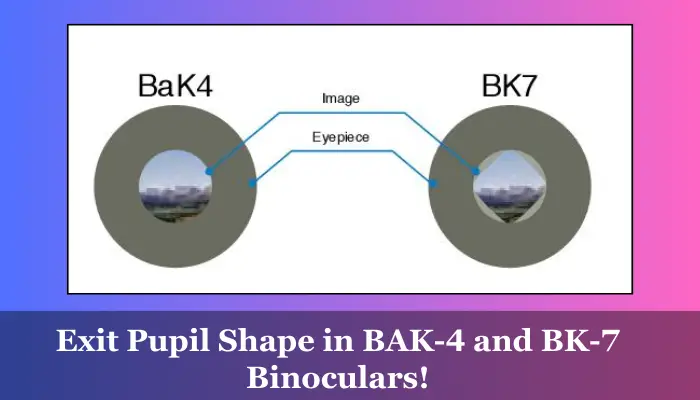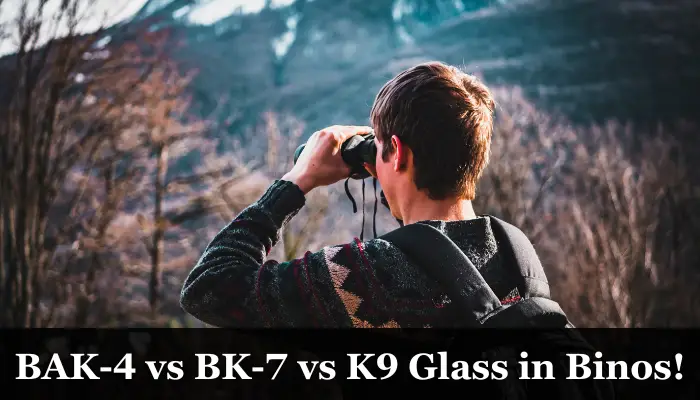This post may contain affiliate links which means I may receive a small commission for purchases made through the links. Learn More
As you know, different glasses are used in the prism and other optical systems of binoculars. BAK-4, BK-7, and K9 are some important types that you will come across when choosing or buying binoculars.
I am sure that you have already heard about those types of glasses which are being used in different types of binos. But many people – maybe including you — don’t know their meanings and properties.
But don’t worry as this guide is going to give you detailed insight into the BAK-7 vs BK-7 vs K9 and at the end, you’ll be able to understand their role in the binoculars. So, without any more delay let’s get started!
Related Article: Roof Prism vs Porro Prism Binoculars
Overview of BAK-4, BK-7, and K9 Glass
BAK-4 glass is considered the superior option among all the other glasses that we are going to discuss in this guide. In the name BA indicates ”Barium” and K represents crone. It is barium crone glass which has a higher refractive index of 1.56, and a lower dispersion power of 56.10.
The binoculars with BAK-4 glass offer ideal optical performance. The combination of brightness and clarity in the visuals uplifts the optical performance of these binoculars. Their lowlight performance is also top-class.
The second glass is BK-7 which is also known as Borosilicate crown glass. It has a refractive index slightly smaller (1.517) than the BAK-4 glass. Its light dispersion value is also on a higher side which makes these lenses a slightly better option than the BAK-4 glass.
Last, but not least, the K9 glass is an affordable and inexpensive solution for those binoculars which are usually sold at very low prices. This glass consists of 9% lead oxide content. However, its refractive index is lower than BAK-4 and BK-7 glass.
In other words, the BAK-4 glass is a premium option for those binoculars that are sold at very high prices as they improve optical performance. The BK-7 glass is a decent option and is used in mid-range binoculars.
However, the K-9 glass is considered the lowest quality glass as it has higher dispersion power. It is used in cheap binos (those which are made for kids). Usually, Chinese brands (which aim to cut the price of binoculars and compromise the quality) use this glass in the binoculars.
Also Read: What Is BAK-4 Prism in Binoculars?
Differences Between BAK-4 VS BK-7 VS K9 Glass
In the section above, I have given you the overview, and the basic information about those different glasses. But the actual guide begins here as I am diving into the details, and going to give you the differences between those three glasses and how they have an impact on the performance of the binoculars.
1- Optical Performance
First of all, let’s talk about the optical performance of the binoculars that matters the most for the users. The BAK-4 glass material has a high refractive index. Due to its higher refractive index, it refractive lights more efficiently and reduces the loss of light.
When there is no loss of light during the refraction, then more light goes to the eyepiece of the binoculars where the users see brighter and sharper visuals. In simple words, this glass reduces the internal reflection and ensures that a minimal amount of light is wasted or lost.
BAK-4 glass also has a very low dispersion value which indicates that it does not let the light to scatter. Instead, it combines or converges light at one single point which reduces the chromatic aberration to some extent.
The other types of glasses have low refractive index, and higher dispersion value which make them an inferior option as compared to BAK-4 glass in the binoculars. If you want to get maximum optical performance from the binos, make sure to choose the one which has BAK-4 glass.
Special Note: You should also keep in mind that the BAK-4 prism increases the transmission of light, which ensures that no light loss happens and maximum light is reached to the eyepiece. Due to that, the brightness of the visuals gets better.
2- Internal Reflections and Stray Light
As I said, the BAK-4 glass has a higher refractive index and lower dispersion value as compared to BAK-7, and K9. So, the BAK-4 prism due to its better refractive index, and higher density reduces the internal reflection. It also reduces the scattering or dispersion of light due to its lower dispersion value.
When there is less internal reflection, there is minimal loss of light. More light goes to the eyepiece of the prism where the user sees brighter visuals. It ultimately increases the visual quality by reducing the chromatic aberration and increasing brightness.
In the case of BK-7, and K9 glass, there will be a lot more internal reflection, and more light will be lost which will affect the visual quality of the binoculars. Keep in mind that BK-7 glass is slightly better than K9 glass because it has a higher refractive index than the K9.
3- Exit Pupil

It is said that the binoculars must have a circular exit pupil so that the user gets all the light (coming out from the eyepiece) and sees brighter visuals. The binoculars consisting of BAK-4 glass usually have circular exit pupils to match the exit pupils of human eyes.
But, those binoculars that consist of BK-7 or K9 glass don’t have circular exit pupil. Instead, they have more squared exit pupils which indicates that these binoculars do not offer optimal brightness. The reason is that due to the squared exit pupil, some amount of light gets lost before reaching the human.
4- Thermal Stability & Durability
The BAK-4 glass is more durable and heat resistant. Even if you keep this glass on a hot summer day, it won’t cause any sort of issue at all. It indicates that this glass is resistant to extremely high temperatures.
On the other hand, the BK-7, and K9 glasses are fragile. They get affected if you keep them in a hot environment. The binoculars consisting of BK-7 or K9 would perform slightly poorly as compared to binoculars consisting of BAK-4 glass.
This is one of the major reasons that the binoculars with BAK-4 glass are more robust, and durable. They are good to use in bad weather conditions, especially in the hot summer days. In terms of durability, the BAK-4 glass stands at the top followed by BK-7, and K9.
5- Weight
The BAK-4 glass has higher density as compared to the BK-7, and K9. Due to its better density, the binoculars consisting of the BAK-4 glass are slightly heavier than those binoculars that don’t consist of BAK-4 glass.
This is where the binoculars with BK-7, and K9 win the race. The reason is that they have lower glass density which makes them lightweight. So, the binoculars that use these glass materials tend to be super light.
Note: If you choose the binoculars consisting of BK-7 or K9, you will get compromised optical performance, but lightweight to carry when walking outside.
6- Applications
The BAK-4 glass falls in the premium category, and its performance is also top-notch. It is a fact that these BAK-4 glasses are expensive, but their performance is worth the higher price. So, these glasses are used in the premium and high-end binoculars which are super expensive.
The BK-7 glass is comparatively less expensive. However, its performance is not ideal as well. It is usually used in mid-range binoculars which are available in 200 to 300 dollars range. Their performance is decent. However, there would be issues in lowlight conditions.
At that end, the K9 glass is the cheapest and most inexpensive option that the manufacturers use to cut the price of the binoculars. Generally, Chinese brands that focus on reducing the price of the product use these lenses to manufacture binoculars.
7- Cost Considerations
By reading the above section, I am sure that you will have an idea of what you are going to get in this particular section. The BAK-4 prism offers ideal optical performance and is very expensive as well. Binos consisting of BAK-4 glass are super expensive.
The BK-7 prism is an affordable option and it is usually used in the mid-range binoculars. This glass type is obviously not ideal, but it offers decent optical performance. The K9 are the cheapest glasses which are usually used in low-priced binoculars.
My Verdict: Which Glass is better for Binoculars?
I have used different binoculars having different prisms, and glass material. But one thing that I can say with confidence is that the BAK-4 glass always offers superior visuals no matter if you use the binos in daylight or lowlight conditions.
One thing which is very encouraging is that more and more brands are now using the BAK-4 glass in the binoculars which is a good thing for those who use the binoculars. It is believed that the usage of BAK-4 glass would become standard.
The latest technologies are helping in manufacturing the BAK-4 glass and getting it ready for binoculars at affordable pricing which is a very good thing. However, if you have a tight budget, then you should go with the BK-7 glass binoculars.
Keep in mind that the binoculars with the BK-7 glass have some limitations as they don’t reduce the chromatic aberration effectively. They also do not perform ideally in the low-light condition which is a drawback. I don’t suggest using the binoculars with K9 glass as it reduces the quality of visuals significantly.
Conclusion
There is no doubt that each glass has its own properties and characteristics. However, I personally love BAK-4 glass as it offers improved optical performance in the binoculars. You can also choose BK-7 glass in case you have a tight budget.
But I won’t suggest you choose the binoculars made with the K9. It really impacts the performance of the binoculars badly. Some Chinese brands use this glass to cut down the price. But choosing such binos is a big trade-off between quality and cost.

I’m a passionate outdoor activist who has got special love for optics. The school studies in optical mechanics and the travelling experience has made me an expert in optics like binoculars, scopes, and other devices. Stay connected with us for in-depth knowledge!

